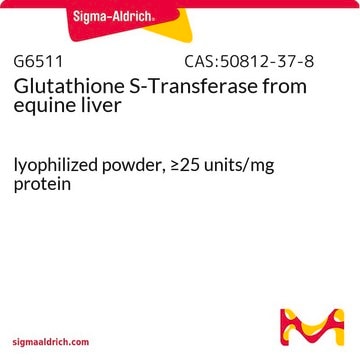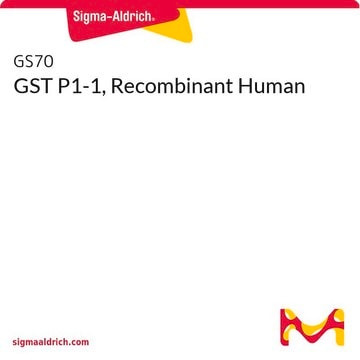G5663
Glutathione S-Transferase from E. coli
recombinant, expressed in E. coli, buffered aqueous solution
Synonym(e):
Glutathione S-alkenetransferase, Glutathione S-alkyltransferase, Glutathione S-aralkyltransferase, Glutathione S-aryltransferase, Glutathione S-epoxidetransferase, RX: Glutathione R-transferase
About This Item
Empfohlene Produkte
Rekombinant
expressed in E. coli
Qualität
for molecular biology
Form
buffered aqueous solution
Mol-Gew.
26 kDa
Konzentration
>0.1 mg/mL
>1 unit/mL
UniProt-Hinterlegungsnummer
Versandbedingung
wet ice
Lagertemp.
2-8°C
Angaben zum Gen
human ... GSTM1(2944)
Allgemeine Beschreibung
Spezifität
second substrate.
In ELISA, 0.5 μg of recombinant glutathione S-transferase is the minimum detectable level of enzyme with an anti-glutatione S-transferase, alkaline phosphatase conjugate.
In immunoblot, 50 ng of recombinant GST is the minimum detectable level of enzyme with an anti-glutathione S-transferase, alkaline phosphatase conjugate.
Anwendung
Biochem./physiol. Wirkung
Warnhinweis
Einheitendefinition
Physikalische Form
Ähnliches Produkt
Lagerklassenschlüssel
12 - Non Combustible Liquids
WGK
nwg
Flammpunkt (°F)
Not applicable
Flammpunkt (°C)
Not applicable
Analysenzertifikate (COA)
Suchen Sie nach Analysenzertifikate (COA), indem Sie die Lot-/Chargennummer des Produkts eingeben. Lot- und Chargennummern sind auf dem Produktetikett hinter den Wörtern ‘Lot’ oder ‘Batch’ (Lot oder Charge) zu finden.
Besitzen Sie dieses Produkt bereits?
In der Dokumentenbibliothek finden Sie die Dokumentation zu den Produkten, die Sie kürzlich erworben haben.
Kunden haben sich ebenfalls angesehen
Unser Team von Wissenschaftlern verfügt über Erfahrung in allen Forschungsbereichen einschließlich Life Science, Materialwissenschaften, chemischer Synthese, Chromatographie, Analytik und vielen mehr..
Setzen Sie sich mit dem technischen Dienst in Verbindung.






